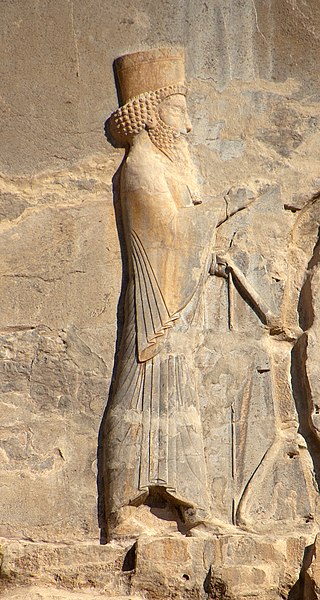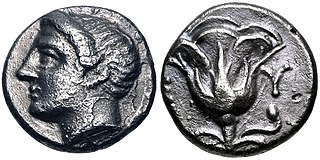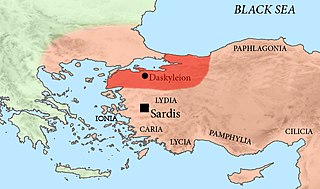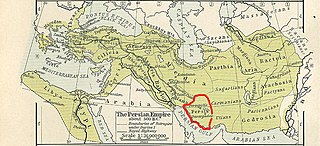Related Research Articles

Darius III was the last Achaemenid King of Kings of Persia, reigning from 336 BC to his death in 330 BC.

Arses, known by his regnal name Artaxerxes II, was King of Kings of the Achaemenid Empire from 405/4 BC to 358 BC. He was the son and successor of Darius II and his mother was Parysatis.

Bessus or Bessos, also known by his throne name Artaxerxes V, was a Persian satrap of the eastern Achaemenid satrapy of Bactria, as well as the self-proclaimed King of Kings of the Achaemenid Empire from 330 to 329 BC.

Ochus, known by his dynastic name Artaxerxes III, was King of Kings of the Achaemenid Empire from 359/58 to 338 BC. He was the son and successor of Artaxerxes II and his mother was Stateira.

Memnon of Rhodes was a prominent Rhodian Greek commander in the service of the Persian Achaemenid Empire. Related to the Persian aristocracy by the marriage of his sister to the satrap Artabazus II, together with his brother Mentor he served the Persian king for most of his life, and played an important role during the invasion of Alexander the Great and the decades before that.

The Late Period of ancient Egypt refers to the last flowering of native Egyptian rulers after the Third Intermediate Period in the 26th Saite Dynasty founded by Psamtik I, but includes the time of Achaemenid Persian rule over Egypt after the conquest by Cambyses II in 525 BC as well. The Late Period existed from 664 BC until 332 BC, following a period of foreign rule by the Nubian 25th Dynasty and beginning with a short period of Neo-Assyrian suzerainty, with Psamtik I initially ruling as their vassal. The period ended with the conquests of the Persian Empire by Alexander the Great and establishment of the Ptolemaic dynasty by his general Ptolemy I Soter, one of the Hellenistic diadochi from Macedon in northern Greece. With the Macedonian Greek conquest in the latter half of the 4th century BC, the age of Hellenistic Egypt began.

Balakros, also Balacrus, the son of Nicanor, one of Alexander the Great's "Somatophylakes" (bodyguards), was appointed satrap of Cilicia after the Battle of Issus, 333 BC. He succeeded to the last Achaemenid satrap of Cilicia, Arsames.
Mithrenes was a Persian commander of the force that garrisoned the citadel of Sardis. According to Cyril Toumanoff, he was also a member of the Orontid dynasty, of Iranian origin. Waldemar Heckel, on the other hand, considers Mithrenes to be a Persian noble of unknown family background. After the battle of the Granicus Mithrenes surrendered voluntarily to Alexander the Great, and was treated by him with great distinction. Mithrenes was present in the Macedonian camp after the Battle of Issus, and Alexander ordered him to visit the captured family of Darius III and assure them that Darius was alive, before changing his mind and assigning the duty to Leonnatus instead. He fought for Alexander at Gaugamela, and ironically he was fighting against an army that included his father Orontes II. Afterwards, Alexander appointed him Satrap of Armenia.

Artabazos II was a Persian general and satrap of Hellespontine Phrygia. He was the son of the Persian satrap of Hellespontine Phrygia Pharnabazus II, and younger kinsman of Ariobarzanes of Phrygia who revolted against Artaxerxes II around 356 BC. His first wife was an unnamed Greek woman from Rhodes, sister of the two mercenaries Mentor of Rhodes and Memnon of Rhodes. Towards the end of his life, he became satrap of Bactria for Alexander the Great.

Mazaeus or Mazday was an Achaemenid Persian noble and satrap of Cilicia and later satrap of Babylon for the Achaemenid Empire, a satrapy which he retained under Alexander the Great.

Abulites was the Achaemenid satrap (governor) of Susiana during the reign of Darius III, and retained the satrapy as a Hellenistic satrap under Alexander the Great until circa 324 BC, when he was executed for sedition.

Orontes II was a Persian noble living in the 4th century BC. He is probably to be identified as the satrap of Armenia under Darius III, and may in fact have succeeded Darius in this position when Darius ascended the throne of Persia in 336 BC.

The Achaemenid Empire or Achaemenian Empire, was the ancient Iranian empire founded by Cyrus the Great in 550 BC; the First Persian Empire. Based in Western Asia, it was the largest empire the world had ever seen at its time, spanning a total of 5.5 million square kilometres from the Balkans and Egypt in the west to Central Asia and the Indus Valley in the east.

Arsites was Persian satrap of Hellespontine Phrygia in the Achaemenid Empire in the 4th century BC. His satrapy also included the region of Paphlagonia.

The Thirty-first Dynasty of Egypt, also known as the Second Egyptian Satrapy, was effectively a satrapy of the Achaemenid Persian Empire between 343 BC to 332 BC. It was founded by Artaxerxes III, the King of Persia, after his reconquest of Egypt and subsequent crowning as Pharaoh of Egypt, and was disestablished upon the conquest of Egypt by Alexander the Great.

Tennes was a King of Sidon under the Achaemenid Empire. His predecessor was Abdashtart I, the son of Baalshillem II, who ruled the Phoenician city-state of Sidon from, having been associated in power by his father since the 380s. It remains uncertain whether his known heir and successor, Tennes, was his son or some other close relative.

Phrasaortes was a Persian satrap of Persis under Alexander the Great from circa 330 BCE. He was a son of Rheomithres. Phrasaortes replaced the Achaemenid satrap Ariobarzanes, who had confronted Alexander at the Battle of the Persian Gate, where he was killed.
The King of Sidon was the ruler of Sidon, an ancient Phoenician city in what is now Lebanon.
Nabarzanes was a high-ranking Persian commander, who served as the chiliarch of the royal cavalry of the Achaemenid King of Kings Darius III.
Oxydates was a Persian nobleman, who served as the satrap of Media under the Macedonian king Alexander the Great from 330 BC to 328 BC. Before his appointment, Oxydates had for an unknown reason been imprisoned at Susa by his former suzerain, the Achaemenid ruler Darius III. He was eventually found and released by Alexander, whom he accompanied to Rhagae. It was during that period Oxydates was appointed satrap of Media, thus replacing Atropates. However, he was convicted of misconduct in late 328 BC, and thus lost his office to Atropates. It unknown what happened to Oxydates afterwards. He may have been arrested or executed by Atropates at the instruction of Alexander, or even managed to escape.
References
- ↑ Heckel, Waldemar (2008). Who's Who in the Age of Alexander the Great: Prosopography of Alexander's Empire. John Wiley & Sons. p. 172. ISBN 9781405154697.
- ↑ "Artaxerxes III Ochus ( 358 BC to 338 BC )" . Retrieved March 2, 2008.
- ↑ Heckel, Waldemar; Tritle, Lawrence A. (2011). Alexander the Great: A New History. John Wiley & Sons. p. 161. ISBN 9781444360158.
